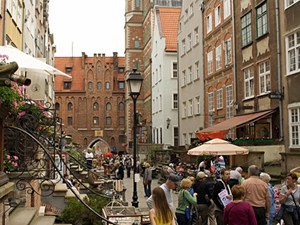
Poland’s retail property market is experiencing a boom, just as the euro crisis threatens to dint Poland
’s economic growth and consumer confidence.

Local developers could complete a further 700,000 sqm of retail space next year, Colliers International predicts in its report.
„In the third quarter of 2011, developers added nearly 90,000 square meters of modern retail space to the Polish market, which represents an increase of 47% compared with the same period last year,” the report says. By the end of this year, Poland’s total retail space is slated to reach 8.6m sqm.
These new retail projects are driving the Polish construction industry, confirms data from Jones Lang LaSalle, a real estate services and management firm. In the first 10 months of 2011, investments in the segment totaled €885m, which represents roughly 49% of the aggregate €1.8bn spent on new investments in the office, industrial, retail and hotel construction segments.
But despite the increasing market saturation, Colliers suggests that retail property developers in Poland have little to complain about. In the third quarter of this year, vacant retail space in the country’s eight biggest cities represented only 1.8% of the total, it said. Warsaw and Szczecin outranked all other Polish cities, with less than 1% of their available retail space vacant, while Gdansk, Gdynia and Sopot closed out the list with a 3% score.
Between January and September, six new shopping centre projects were completed in Poland, adding some 251,900 sqm of retail space to the local market, according to Colliers. Moreover, analysts say the continuing expansion of US and European brands to Poland is spurring new investments in the retail construction segment.
„Internationally recognized brands such as GAP, Cinnabon and Toys R Us, which are currently opening their first stores in Poland, will very likely increase the attractiveness of many shopping malls,” says Anna Radecka, a senior associate at Colliers International’s Retail Agency. „But what is most important to potential investors is the general market optimism and the availability of credit to both developers and tenants.”
Pricking the bubble
That optimism may be soon tested. In its draft budget for 2012, Poland’s Ministry of Finance said the country’s GDP will expand by 4% next year, but few expect this to be borne out. „It would be unreasonable to expect this 4% to happen next year,” Jan Krzysztof Bielecki, chairman of the economic council to the Polish prime minister, said in an interview with local news channel TVN CNBC.
On November 10, the European Commission cut its growth forecasts across Europe, predicting growth in Poland at 2.5% and 2.8% for 2012 and 2013 respectively. „Turbulence in financial markets have begun to weigh on consumer and producer confidence, ultimately limiting private investment expenditure, employment growth and the expansion of private consumption,” the Commission said.
Banks too are reducing their growth forecasts, with Swiss banking giant UBS recently downgrading its forecast from 3.3% to 2.9% in 2012. This still exceeds the estimates for the Czech Republic at 1%, and Hungary at a mere 0.5%, but further financial turmoil in the Eurozone could signal another round of growth downgrades in the CEE region.
This could spell trouble for retailers. „A scenario with a weaker consumption outlook and a further tightening of the belt by Poland could have an impact on the retailers’ revenues,” admits Malgorzata Kobziakowska, an associate at Colliers International’s Retail Agency. „But most of them have learned their lesson from the first phase of the downturn in the years 2009 to 2010, which is reflected in the improved strategies of lease negotiations,” she says. „Even if consumer spending will drop in 2012, the store chains which were skillful in negotiating long-term leases will most likely manage to keep all their retail surface.”
To date, consumer spending in Poland has not taken a hit from the turmoil in the Eurozone. In the third quarter of 2011, Polish retail sales were up 7.1% over the same period a year earlier, according to figures from the Central Statistical Office (GUS).
Local analysts believe the Polish market is in better shape than most other retail property markets in the region. „When comparing Poland to the Czech Republic and Hungary, we have to keep in mind that the Polish market has a total retail space of 8.6m sqm, while the Czech market has 3m sqm and the Hungarian only 1.3m sqm, but also that this market is much more diversified in Poland,” explains Radecka. „The results of our analysis show that the market situation in Poland is stable, developers launch new projects and new store chains are lining up to expand their businesses here.”
Jaroslaw Adamowski – Business New Europe
Photo: Polish News
